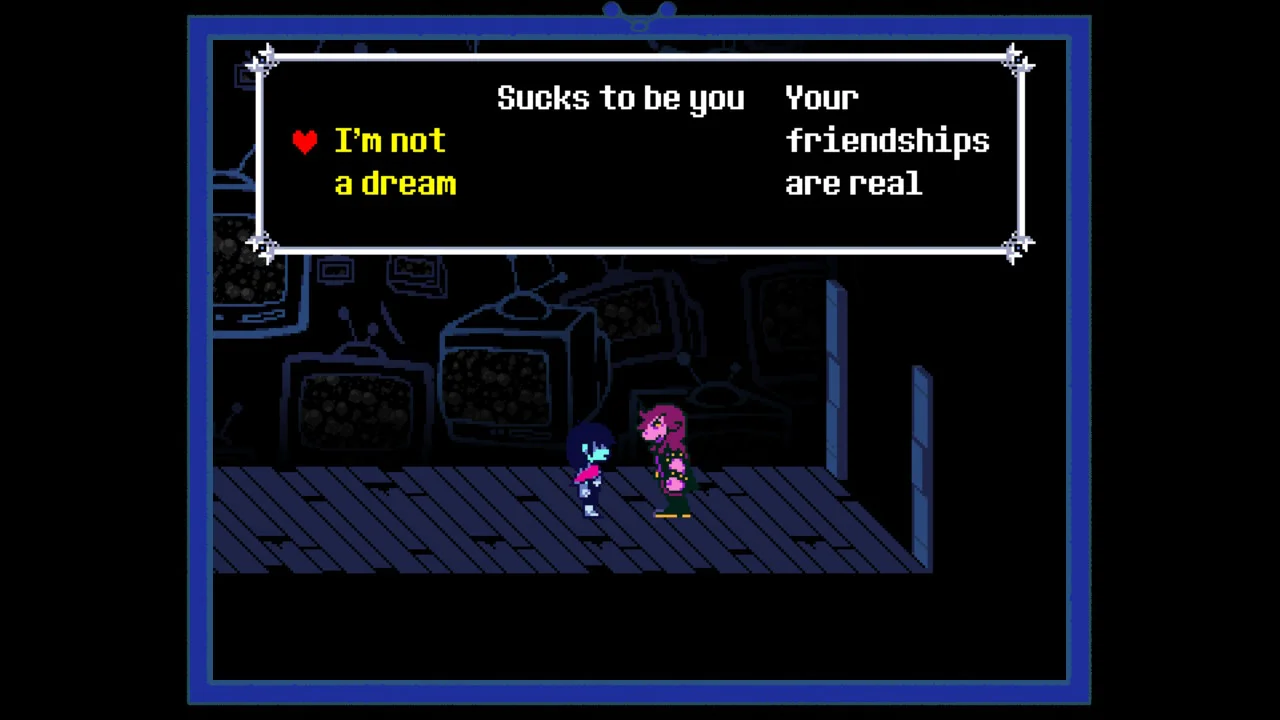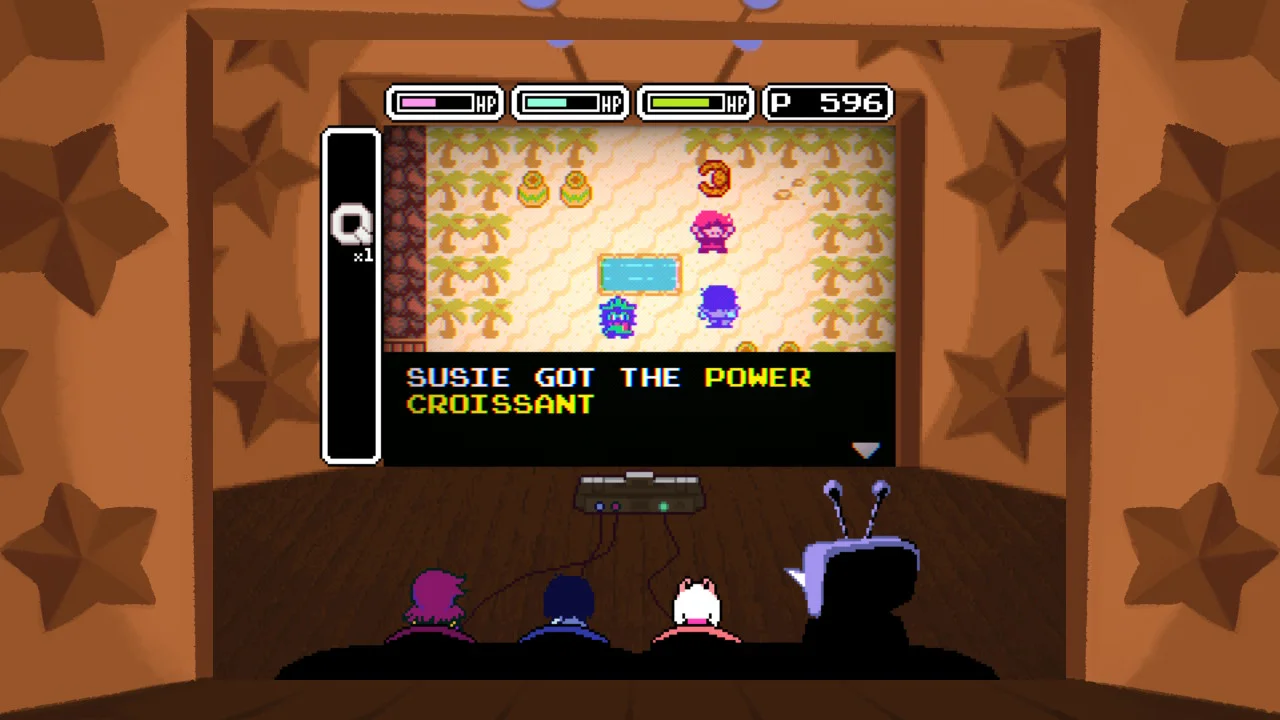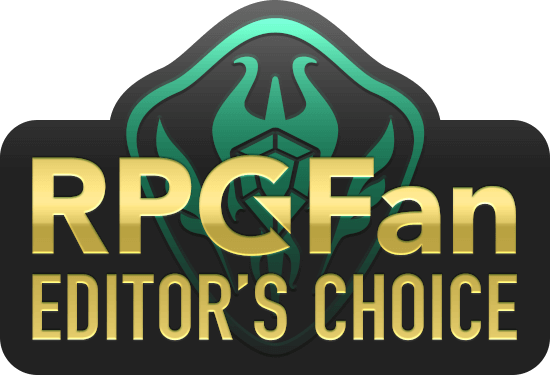In my recent review of Chapters 1+2, I discussed Deltarune mainly on a macro level: how its legacy ties to Undertale, its main design iterations, and the broad narrative themes it sets up. Having already gone over that, I won’t be retreading any of it. If Toby Fox can just pick up from where he left off, then so can I! Consider this Part Two to a growing review of this fascinating game.
This also serves as a nice excuse to discuss and appreciate Chapters 3+4 on a closer, micro level. And, really, the variety each chapter provides is the standout quality of Deltarune so far. Don’t worry, though. I know not everyone will have gotten their hands on this paid release yet may be curious to hear about the new content, so I will stop myself from specifying any major story events. With that said, this is a game full of delightful surprises, and I will go into some of them to sing its praises.
Even more than the first two chapters, 3+4 show just how much care Fox’s team are dedicating to make each chapter of Deltarune feel distinct and cohesive as individual pieces of a greater vision. Almost every moment of these chapters provides meaningful content. The game displays more creativity in an hour of playtime than most games achieve in a dozen hours of a derivative gameplay loop. It offers such a surplus of joy and intrigue that it makes the term “gameplay loop” feel like an excuse for lazy designers to recycle content and waste players’ time. Yes, Deltarune is taking what feels like forever to make. However, this release is evidence of the magic this painstaking process is yielding.
The third and fourth chapters feel like a ride through flavor town before the overarching story’s stakes get higher. As the “middle” section of the game—The Two Towers of the tale—major plot turns are not the focus here. Instead, these chapters add substance and context to what we already know. Both Susie and Ralsei evolve into more complex characters than their portrayals in the opening chapters. The main party dynamic feels stronger at its core, but there’s some underlying tension developing as well. Fox is leaving delectable trails of breadcrumbs for fans to obsessively speculate on where they may lead.
I’ll throw in a critique before gushing out more praise. If there’s one aspect of Deltarune I expected to bring more to the table in these chapters, it’s the combat mechanics. In regular encounters, mind you. Learning to dodge enemy attack patterns and Act-ing with your companions is still a consistently fun exercise. The issue is these battles rarely feel threatening. And since the game hands out currency so generously, I started wishing for an Escape mechanic after I had already recruited a monster type. Maybe I’ve just played Undertale and some of its related properties too many times, but I found myself occasionally getting tired of going through the motions after quickly figuring out the optimal strategy for a new enemy type. The game hasn’t introduced more skills for strategic TP use, either.
This would feel like a larger problem if Fox didn’t keep gameplay fresh in myriad other ways, or if the bosses weren’t so cleverly designed and nicely balanced. One of them abruptly swaps through minigame challenges throughout its phases. Another has your Soul (the red heart the player controls) navigating dark mazes of increasing complexity to reach a key and make for the exit—but spend too long doing so and a nerve-wracking pumpkin will start chasing you. The game continues its trend of featuring one major secret boss in each chapter, which still represent the peak of Deltarune’s combat design (and music!) in their own creative ways.
Each chapter’s core mechanical and narrative premise further mitigates the above critique. Coming in right from a replay of Chapters 1+2, I loved Chapter 3’s giddy experimentation. The Dark World takes place in Kris’ TV this time around. Mr. “Ant” Tenna, a hyperactive TV show host who straddles the line between friend and narc, presides over this area. Unlike the rest of the pixelated cast, Tenna is an (unusually large) pre-rendered 3D model. He feels like an aesthetic reference to the characters from Moon: Remix RPG Adventure, a known inspiration for Undertale. His excessive dialogue and goofy animations are a constant source of amusement throughout the chapter.
For most of Chapter 3, your party are guests in Tenna’s game show. This primarily involves playing “The Legend of Tenna,” an 8-bit Zelda-style game. That’s right. The developers made a whole mini-Zelda for this chapter that you play in segments. Susie and Ralsei join you with their own controllers and get up to amusing shenanigans as you explore. It’s so. Damn. Charming. Props to the team for programming these AI-controlled sprites to feel like your squad is actually there playing the game with you. Mix in some hilarious quiz segments, a handful of fun minigames, and an incentive to perform perfectly in battles to achieve S-Rank on Tenna’s show, and you end up with a delightful few hours of game.
Chapter 4 begins with an incredible sequence in the Light World where Kris and Susie visit Noelle’s house and some strange events ensue. Once you reach the chapter’s Dark World, it plays more conventionally than Chapter 3. The return to familiarity is a sensible follow-up. The setting is more moody than previous chapters, which feels appropriate considering its focus on fleshing out the world’s lore. It’s a striking mix of a library and chapel. The lighting is sombre, the music reverential. Glass windows depict The Legend of Delta Rune’s prophecies. And the chapter’s central character—a cunningly wise old tortoise Undertale fans will recognize as reminiscent to Gerson—subtly questions the certainty of your party’s pre-destined fate.
Chapter 4 is also quite long, and this is where I first felt Deltarune’s combat stagnate a little. It doesn’t help that it has the fewest enemy types of all chapters for some reason. Yet progression from room to room yields consistently interesting dialogue, eye and ear candy, and new or expanded exploration mechanics. Puzzles vary from rearranging bookshelves to open new paths and navigating dark rooms based on sound projections, to using a new tool to climb through obstacle courses. With this chapter, Deltarune has fully revealed itself as a true RPG epic.
The story’s “weird route” can be continued in Chapter 4 if you started it in Chapter 2. Chapter 3 contains hints of this alternate story path baked into its one route, revealing its existence more clearly to those who didn’t clue into its very specific conditions in the previous chapter. Without giving anything away, the context around the new story developments makes the thematic direction of this route even more intriguing.
If Undertale’s story deals in the innocence or corruption of childhood, Deltarune is about adolescence. It’s not as clear and purposeful as its predecessor, partly because it has the tough task of following up on an experience that feels perfectly coherent, but also because it goes bigger. It is messier but admirably wide-eyed in that messiness. That’s clear enough from the scope, though it truly comes into perspective with the characters. Undertale’s characters had immediately endearing personalities as well as depth, but what you saw was generally what you got. Deltarune’s teenagers are quite the opposite.
The way they present themselves and unravel reveals baggage from close relationships and internal conflicts. The cast is dealing with social and existential dilemmas fitting for their age, and Toby Fox’s writing extends enormous empathy while revealing their baggage slowly and purposefully. Undertale’s quirkiness served a purpose in characterizing monsters as adjacent to yet distinct from humans, and it made for plenty of hilarious dialogue. There’s still plenty of laugh-out-loud quirk in Deltarune’s writing, but there’s also clearly more care toward conveying emotional nuance. Just like the Fight/Act commands are no longer a simple binary, it takes more nuance than good/evil to understand these characters.
As if there was any doubt, Deltarune’s two new chapters build on the foundation of its predecessors in ways both expected and unexpected. There is a level of care here extending through design, aesthetics, and storytelling that is impossible not to marvel at. From the kitschy experimentation of Chapter 3 to the grandiose presentation of Chapter 4, Deltarune is becoming harder not to pay attention to and tip one’s hat at. My recommendation? Play it now. And play it again later. There’s literally nothing else like it. Purchasing the game will get you all the remaining chapters released as expansions. Enjoy the ride so far—and the suspense before the next drop.







